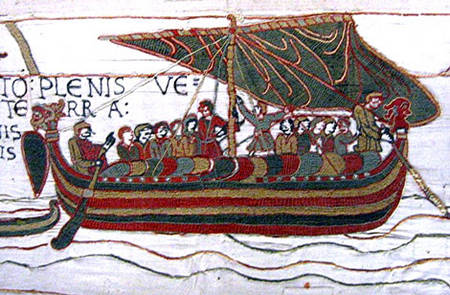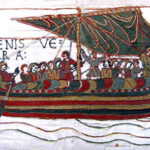Viking Ships
Ship
Medieval
Quick Facts:
The Viking ship was a strong durable ship that allowed the Norsemen of Scandinavia sail long distances and raid far away kingdoms.
Viking ships were very versatile. Both of their two main styles of ships fared well against the dangers of open sea travel as well as on the narrow rivers of the foreign lands they were raiding. This versatility allowed the Vikings to explore lands as far west as Canada, as far east as Russia, and as far south as Africa!
Legends about the Viking Age present Vikings as ruthless invaders, but their culture and history were far more complex. In the 6th Century BCE the Vikings did begin to raid the monasteries on the coasts of England and, after finding their campaigns to be successful fundraisers, they continued their pillaging in France and Russia. In the 9th century, the Vikings began to sail farther west, eventually coming to the land they named Vinland, which is now known as Newfoundland in Canada. There is even archaeological evidence of trade between the Vikings in Scandinavia and the inhabitants of Africa and Asia! The Vikings’ marine success was due, in large part, to the seaworthiness of their ships. These ships were very versatile, allowing the Vikings to sail on the open sea as well as the narrow rivers of the European mainland. The Vikings were the best ship designers of their time, and much like the Phoenicians they were master navigators and sailors.
The Vikings used two main types of ships for these expeditions. The first was known as a drakkar, or “longship,” designed for carrying raiding parties. The longship had a single sail and mast, which were removable for storage, and carried oars that the crew used to propel the ship forward. The hull also assisted in the smooth sailing of a drakkar. It was designed to be flexible, so that it would move with the waves instead of against them. The head of a dragon, horse, or swan was usually sculpted onto the bow. The Vikings also mounted their shields along the side of the vessel to have them ready in the event of an attack. These ships were likely the ones used in the raids in England and France.
The second kind of ship was known as the knörr, meaning “halfship”. The halfship was a merchant ship used for carrying cargo such as cattle, wool, timber and wheat. It was a bulkier vessel, with a wider and deeper hull than the longship, holding between 70 and 100 people. Ornate decorations signifying different aspects of Viking culture and the Norse religion and mythology were typically carved into the sides of these ships. Unlike the longship, the knörr carried fewer oars, and these were used for docking only. The mast on a knörr was a permanent part of the ship and could not be removed. These types of Viking ships were probably close to the ship on which Leif Eriksson traveled to North America.
Vikings used their ships with care. They followed the seasons, venturing out to sea in the spring and returning to the safety of home at the end of autumn. They put a lot into creating strong durable ships and became the masters of the Northern Atlantic.
- Floki Vilgerdarsson Viking ship
- Dragon Figurehead, Unknown Maker, The Mariners’ Museum (1937.0491).
-
Waldman, Carl, and Alan Wexler. Encyclopedia of Exploration, Vol. 1-2. New York: Facts On File, 2004.
-
Weaver, Stewart A. Exploration: A Very Short Introduction. New York: Oxford University Press, 2015.
-
Sawyer, P.H. Kings and Vikings: Scandinavia and Europe AD 700-1100. London: Routledge, 1984.
-
Villiers, Capt. Alan. “Vikings and Longships, Scourge of Northern Seas,” in Men, SHips and the Sea. Washington DC: National Geographic Society, 1962.



